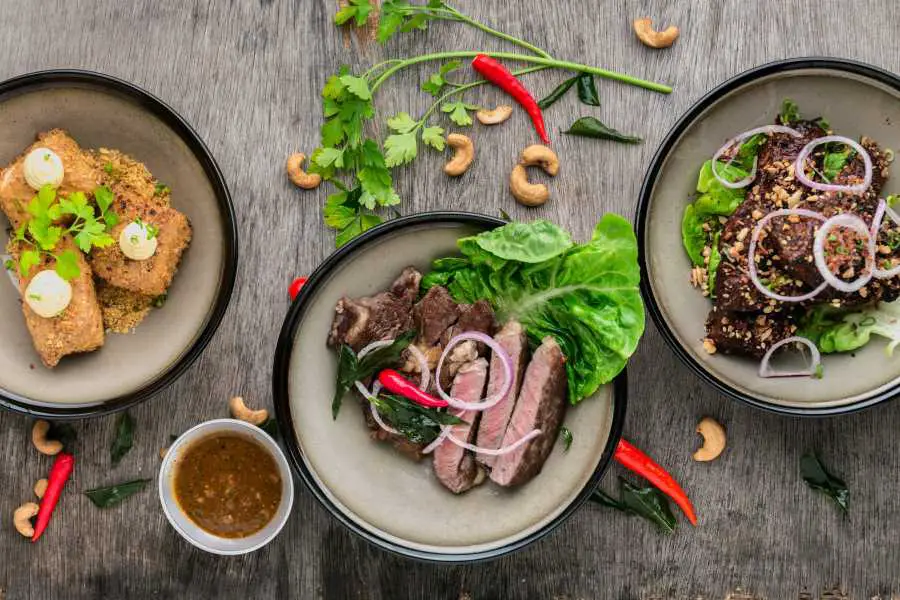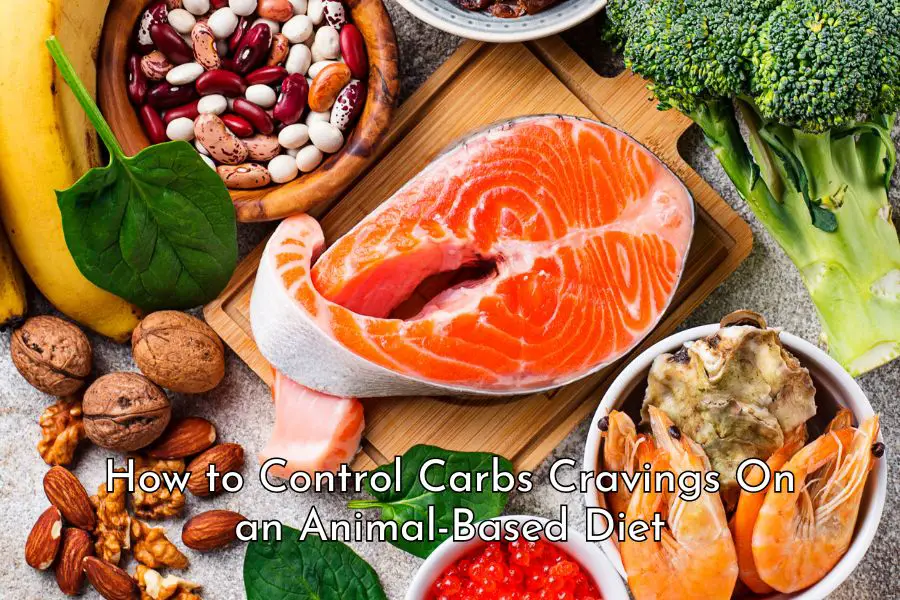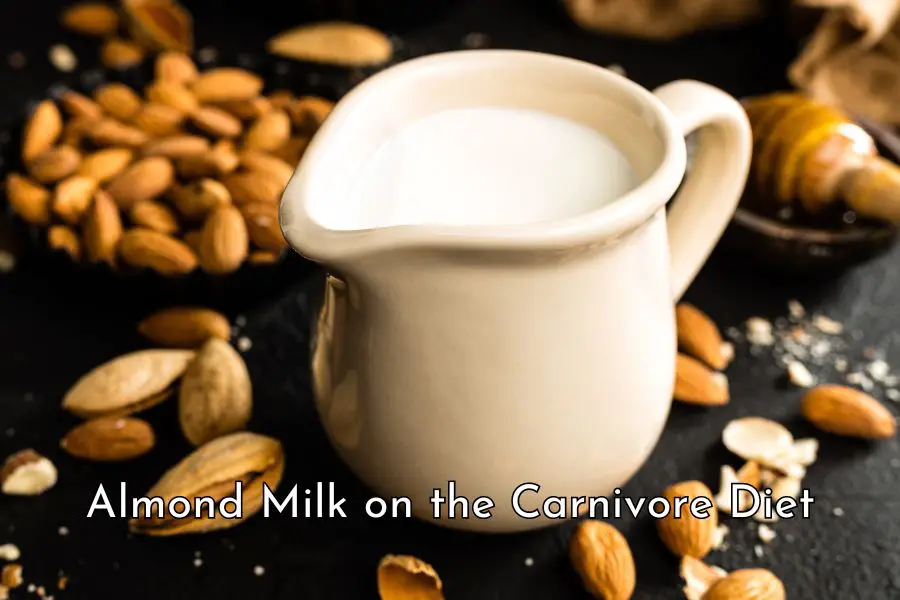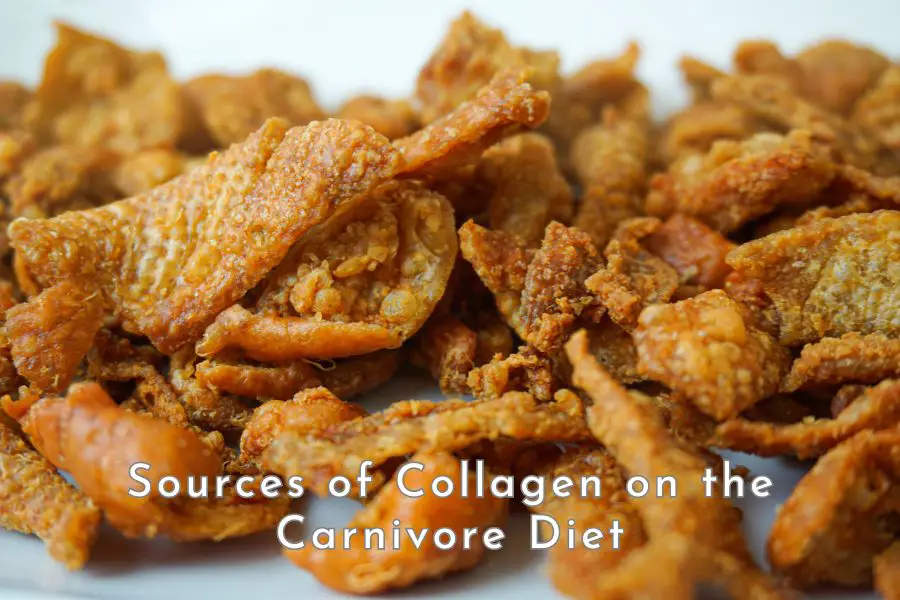What is the healthiest diet for humans? Is it a vegan, vegetarian, paleo, pagan, or Mediterranean diet?
In this article, I argue that the healthiest diet for humans today is the ancestral version of the carnivore diet which consists mostly of animal-based foods and occasionally a very small quantity of seasonal plant foods. This is exactly what our ancestors used to eat for millions of years that determines the genetic makeup that we inherit today.
I also review a number of popular diets that are widely perceived as ‘healthy’ and argue that these diets are inferior compared to the ancestral version of the carnivore diet.
This has been a challenging post for me to write but I’ve enjoyed researching and writing it and I hope you enjoy reading it too and find something useful from it.
Contents
- Approach to finding the healthiest diet for humans?
- What are humans designed to eat?
- What should modern humans eat today?
- Why the ancestral carnivore diet is the healthiest diet for humans today?
- Why other ‘healthy’ diets are inferior compared to the ancestral carnivore diet?
- Conclusion
1. Approach to finding the healthiest diet for humans
Healthiest diets for all animals are blindingly obvious
The healthiest diet for lions consists of a wide variety of animals that they can hunt.[1]
The healthiest diet for giraffes consists of new shoots and leaves, mainly from the thorny acacia tree.[2]
The healthiest diet for pandas consists of the leaves, shoots, and stems of bamboo. [3]
The healthiest diet for seals consists of seafood, mainly fish, and maybe squid, other mollusks, and crustaceans.[4]
And so the list goes on.
Animals in the wild know exactly what they should eat.
They all eat a very small and specific range of foods that their bodies are designed to eat.
And we know that too. When in the zoos, they are all fed their natural diet. Lions are fed meat, penguins are fed fish, koalas are fed eucalyptus leaves and pandas are fed bamboo.
But humans are confused about what we’re supposed to eat and suffer the consequences
It seems that only the human race, the most intelligent species on the planet, hasn’t been able to agree on what exactly is the best diet for us.
‘What is the healthiest diet for humans’ is a billion-dollar question.
So, why the confusion?
In my view, this is due to the fact that these days there are so many food choices available that are promoted by powerful groups with vested interests.
Meat producers would argue that meat is nutritious and healthy. Fruit and vegetable producers would argue that plant-based food is healthy, ethical, and environmental-friendly. Junk food manufacturers would argue that chips, candies, and soft drinks are convenient, fun, and fine, we just need to eat and drink in moderation. And governments, crippled by powerful lobby groups, would tell us to eat everything but in the right balance as specified in their dietary guidelines, healthy food pyramids, healthy eating pyramids, or healthy eating plates.
In fact, we are inundated with so many things labeled as healthy these days: from healthy initiatives, healthy messages, to healthy food choices.
However, the reality is the world is getting fatter and more unhealthy by the day. In 2016, 1.9 billion adults worldwide were overweight and 650 millions of them are obese. There were also 340 million children and adolescents who were overweight or obese and these numbers are on the rise. The worldwide prevalence of obesity nearly tripled between 1975 and 2016.[5] There is no indication of a slowdown or reversal of this trend anytime soon.
It is more important than ever, on an individual level as well as for the healthy survival of humanity in the long run, to find out what the right diet for us is, what is the best for us to eat, in order to not only survive but thrive.
How to find the healthiest diet for humans?
We must look at what the human body is designed to eat to find the answer
In my view, to find out what the healthiest diet for humans is, we should start by looking at what the human body is biologically designed to eat rather than looking at the available food choices today and constructing the best diet out of these choices.
This is because, like all other animals, the human body today is the result of millions of years of evolution. It is designed in a specific way to adapt to what we have been eating for millions of years, not what we have been eating over the last few centuries, and definitely not over the last 50 years or so. Therefore, continuing to feed it what it has been adapted to eat over the long evolutionary process would be the most sensible course of action.
Environment, societies and human behaviors can change rapidly but evolution is super slow.
While it is true that humans have an amazing ability to adapt and eat a variety of food to survive, biological changes at the genetic level are exceedingly slow. If we eat junk food only for the next million years, sure, we will evolve or devolve somehow to adapt to this junk food diet, but certainly not in the space of less than 100 years or so.
Constructing a healthy diet out of food choices available today and other constraints is a mistake
I am aware of the fact that some people and organizations have attempted to construct a healthy diet for humans by looking at a number of factors such as epidemiological evidence, available food choices, their environmental food prints, sustainability, and ethical implications all at once.
However, in my view, this is not the best course of action because: i) we will be discounting the importance of or ignoring our evolutionary past that determines the genetic make-up we inherit today, and ii) we will be constrained by unhealthy food choices presently available as well as mistakes of our recent past.
Unhealthy food should not become healthy because getting rid of it will result in millions of job losses.
Unhealthy food should not become healthy because that is the only way we can feed the world’s growing population.
Similarly, unhealthy food should not become healthy because it is perceived as good for the environment.
We should not be conflating the two independent questions: i) what is the healthiest diet for humans, and ii) how can we feed ourselves this healthy diet in an ethical and sustainable manner.
We are an intelligent race. Once we agree on what the best diet for us is, we then can look at the subsequent question of how can we can source these healthy foods for us in an ethical and sustainable manner. This is a topic that is outside the scope of this post but I will address it at a later time.
2. What are humans designed to eat?
Once upon a time, this would have been blindingly obvious too.
For most of human history, our ancestors had to hunt, scavenge and gather to survive and there were only a few food choices available. But they not only survived but thrived. Their brain size increased rapidly during the evolutionary process and so was their intelligence.
So what did they eat?
Meat. Lots of meat.
Multiple avenues of evidence all point to the fact that for most of human history, meat was what our ancestors ate.
Our ancestors were hyper-carnivorous apex predators that ate mostly meat from large animals for 2 million years
In a rigorous study led by Doctor Miki Ben-Dor and Professor Ran Barkai of Tel Aviv University and published in the Yearbook of the American Physical Anthropology Association, January 2021, the researchers reconstructed the human trophic level during the Pleistocene period by looking at multiple avenues of evidence.[6]
Previous studies relied heavily on an analogy with the diets of recent hunter-gatherer groups to construct the human trophic level during the Stone Age. However, this is futile, according to Dr Ben-Dor, because the ecosystem of the 20th century hunter-gatherer societies is totally different from the ecosystem that existed 2 million years ago.[7]
Environment and human behaviors can change rapidly, but evolution is slow and the body remembers. The adaptation to a trophic level is embedded in modern humans’ biology in the form of genetics, metabolism, and morphology.
Therefore, in this latest study, Dr Ben-Dor and his team examined the memory preserved in the human body, its metabolism, genetics, and physical build. They adapted a palaeobiological and paleoecological approach and looked at the evidence from human physiology and genetics, archeology, paleontology, and zoology and identified 25 sources of evidence in total.
In summary, the totality of evidence shows that humans were definitely not generalist omnivores as previously widely believed. Instead, they were hyper-carnivorous apex predators that ate mostly meat from large animals for 2 million years. Their diet was definitely not that of typical hunter-gatherer societies.
Only the extinction of large mammals due to extensive hunting led to a gradual increase of plant foods in the human diet and eventually led to the advent of agriculture and humans were forced to become farmers to survive.
You can read the study in full here. Some of the important findings are reproduced below.
A. Biological evidence
- Bioenergetics. Humans had high energetic requirements for a given body mass and had a shorter time during the day to acquire and consume food. Hunting provides a tenfold higher energetic return per hour compared to plants, leaving little room for flexibility between the two dietary components
- Diet quality. In primates, a larger brain is associated with high energy density food. With the largest brain among primates, humans are likely to have targeted the highest density food, animal fats, and proteins
- Higher fat reserve. Humans have higher body fat reserves than primates and are uniquely adapted to lengthy fasting. This adaptation may have helped with overcoming the erratic encountering of large prey
- Genetic and metabolic adaptation to a high-fat diet. Humans shut down regions of the genome to accommodate a high-fat diet while chimpanzees open regions of the genome to accommodate a high sugar diet
- Stomach acidity. The acidity of the human stomach is even higher than in carnivores, equaling that of scavengers indicating a meat diet in which the acid would provide protection from harmful bacteria
- Insulin resistance. Humans, like carnivores, have low physiological insulin sensitivity
- Gut morphology. Humans’ gut morphology and relative size are radically different from chimpanzees’ gut. Longer small intestines and shorter large intestines are typical of carnivores’ gut morphology and limit humans’ ability to extract energy from plants’ fiber
- Mastication. Reduction of the masticatory system size already in Homo erectus, compared to early hominins, who relied on terrestrial vegetation as a food source. The reduced size is compatible with meat and fat consumption
- Postcranial morphology. A set of adaptations for endurance running is found already in Homo erectus, useful in hunting. Shoulders adapted to spear-throwing in Homo erectus, but limited tree climbing capability
- Adipocyte morphology. Similar to the morphology in carnivores which suggest that the energy metabolism of humans is adapted to a diet in which lipids and proteins rather than carbohydrates
- Age at weaning. Carnivores wean at a younger age, as do humans
- Vitamins. The hypothesis for required nutritional diversity to supply vitamins is contested. It appears that all vitamins, including vitamin C, are supplied in adequate quantities on a carnivorous diet.
B. Archeology
- Stone tools. Stone tools specific to plant food utilization appear only some 40 thousand years ago, and their prevalence increases just before the appearance of agriculture, signaling increased plant consumption toward the end of the Paleolithic
- Zooarchaeology. First access to large prey appears already in Homo erectus archaeological sites 1.5 million years ago. Humans also hunted large carnivores
- Targeting fat. Humans concentrated on hunting fatty animals at substantial energetic costs. They preferentially brought fatty parts to base camps, hunted fattier prime adults, and exploited bone fat
- Stable Isotopes. Nitrogen15 N isotope measurement of human fossil collagen residues is the most extensively used method for determining trophic level in the last 50 thousand years. All studies show that humans were highly carnivorous until very late, before the appearance of agriculture
- Dental pathology. Dental caries, evidence of substantial consumption of carbohydrates, appeared only some 15 thousand years ago in groups with evidence of high plant food consumption
- Behavioral adaptations. A comparison of humans’ behavior patterns with chimpanzees and social carnivores found that humans have carnivore-like behavior patterns. Food sharing, alloparenting, labor division, and social flexibility are among the shared carnivorous behaviors.
A heavily meat based diet was what made us an intelligent race
As can be seen in the timeline below, 2.6 million years ago, the human brain size was about 650cc. At the time, they were likely only scavengers and had access to leftover parts of the animal, like marrow and brains.
However, subsequently, archeological evidence shows that humans began to hunt and had access to all parts of the animal. They dined on mostly large animals for over 2 million years. This coincided with the massive increase in the human brain size during this period to around 1500cc.
While we can’t prove beyond reasonable doubt that the meat-based diet was what directly caused the human brain to grow substantially, available evidence indicates that it was most likely so.
With the extinction of large mammals and the advent of agriculture, the increase in consumption of plant-based food coincided with the decrease in the human brain size to about 1350cc.
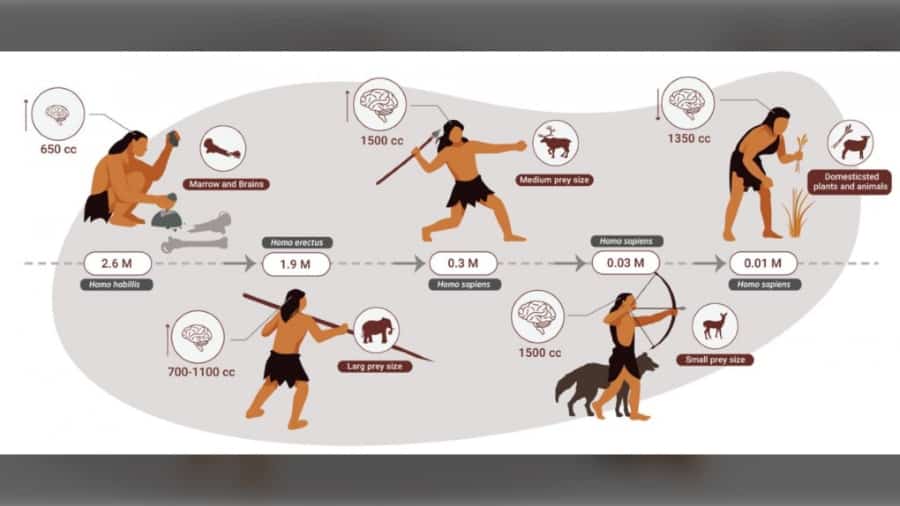
Conclusion
The human body is designed to eat meat, full stop.
If human history is reduced to a 24 hours timeline, for approximately the first 23 hours and 55 minutes, meat was mostly what we ate. But with the appearance of agriculture, during the last 5 minutes, plant food intake has increased exponentially. And during the last 5 seconds, with the invention of fast food and soft drinks, ultra-processed food has become a prominent feature of the modern-day diet in every corner of the globe.
Despite this enormous change in living conditions and available food choices from the dawn of agriculture until now, our genetic make-up remains largely the same as at the end of the Paleolithic period, as Professor Boyd Eaton of Emory University put it succinctly:
We are the heirs of inherited characteristics accrued over millions of years, the vast majority of our biochemistry and physiology are tuned to life conditions that existed prior to the advent of agriculture. Genetically our bodies are virtually the same as they were at the end of the paleolithic period. The appearance of agriculture some 10,000 years ago and the Industrial Revolution some 200 years ago introduced new dietary pressures for which no adaptation has been possible in such a short time span. Thus an inevitable discordance exists between our dietary intake and that which our genes are suited to. [8]
The significant departure from the diet that we are meant to eat has arguably resulted in a host of modern-day lifestyle diseases such as obesity, diabetes, cancer, and cardiovascular disease.
3. What should modern humans eat today?
General principles in an ideal world
So we’ve established that, despite massive changes in the environment, living conditions, and food choices, the human body today is still designed to eat a meat-based diet like what our ancestors ate.
However, the living condition has changed substantially since the time of our meat-eating ancestors, so what exactly should we eat today?
The answer is simple: we just have to try our best to eat the way our ancestors used to eat.
They initially ate whatever they could scavenge, and that probably was the leftover parts of the animal, like marrow and brains. But later on, when they learned to hunt, they would have had access to the whole animal and ate everything.
They moved about to find food, hunted and ate large mammals that roamed freely in their natural environment. They were unlikely to dine on a specific type of food for a long period of time.
They ate raw and cooked.
And of course, they ate whole unprocessed food.
The way our ancestors ate can be summarized in the following principles for the modern-day carnivores to follow:
- Eat from a wide variety of animal sources to ensure sufficient nutrients. Eat meat (e.g. beef, lamb, goat, bison, pork, chicken), seafood, eggs, bone marrow, bone broth, organ meat, butter, cream, yogurt, and tallow
- Eat nose-to-tail or as many different parts of an animal as possible. Eating this way will respect the sacrifice of the animals, minimize waste while ensuring you have all the necessary materials you need to build a perfectly healthy human body
- Eat from naturally or well-raised animals as much as you can afford (e.g. grass-fed ruminants and pasture-raised pork and chicken or wild-caught animals)
- Eat unprocessed or minimally processed foods to preserve nutrients and minimize harmful additives
- Eat both cooked and raw if it’s safe and tolerated because some nutrients can be destroyed due to prolonged cooking
- Eat a small amount of seasonal plant foods occasionally.
We don’t know to what extent plant food had featured in our ancestors’ diet. But my guess is that, given the fact that they descended from plant-eating primates, they were likely to have at least eaten some plant food in the wild between successful hunts to survive.
And the above is what I call the ancestral carnivore diet which basically consists of a wide variety of animal-based food in their most natural form and occasionally a small amount of plant food.
However, clearly, it is hard for most of us today to adhere to these principles.
Most of us don’t have access to grass-fed, pasture-raised or wild-caught animal source foods. They are expensive, out of reach for many, and not widely available.
It is estimated that today around 90% of farmed animals live in factory farms. These animals, from cows, pigs to chickens and fish, are forced to live in crowded and unhealthy conditions, are fed a diet very different from what they are meant to eat, and are given antibiotics, hormones and other drugs. [9, 10, 11, 12, 13, 14, 15, 16, 17, 18, 19, 20]
And most of us, unfortunately, have to eat meat and other produces from those animals.
The nose-to-tail way of eating has also been forgotten in many parts of the developed world. You’re more likely to find livers, hearts, kidneys, and giblets in manufactured pet food than in the meat section for human consumption.
Given budget constraints and available food choices, how should we practice the ancestral way of eating and what should we eat?
Let’s explore this question below.
Practical rules of thumb in the real world
By looking at farming conditions, diets and nutritional profiles of farmed animals, the best animal source food today appears to be ruminant meat and ruminant organs.
This is because while farmed pigs and poultry are most likely to spend their entire life indoors and are fed an unnatural diet, ruminants like cows, sheep and goats are mostly raised outdoors and are fed a diet closer to their natural diet.[21]
Ruminant meats also have a lower level of polyunsaturated fat and better omega 3 to omega 6 ratios than pork and poultry.[22] Polyunsaturated fats, especially omega 6, have been linked to increased cancer risk, suppression of the immune system, lowering good cholesterol (HDL-C) and increasing the susceptibility of LDL to oxidation.[23]
For more detailed information on how farmed animals are raised and why ruminants are generally a better choice, please read this post.
Taking the above into account, the practical rules of thumb for most of us today would be as follows.
Eating a wide variety
Eat a variety of ruminant meat such as beef, lamb, goat, bison, deer, kangaroo, and any other wild games. This should be the staple of your carnivore diet.
Add pork and poultry for variety but only sparingly. If you can’t afford or don’t have access to ruminant meat, choose lean cuts of pork and poultry because they are low in polyunsaturated fats.
Aim to have fatty fish twice a week for a boost in your omega 3 intakes. There is some omega 3 in ruminant meat and other meat but the level is low. A 100 gram serving of salmon delivers 2,506 mg of omega 3 compared to only 42mg per same serving of beef.[24]
If you can’t afford wild-caught seafood, tinned wild-caught fish is probably a better choice than fresh farmed fish. Housed in crowded aqua farms, farmed fish are likely to have drugs, chemicals, and pollutants in them. For example, farmed salmons are fed a diet different from their diet in the wild that makes their flesh grey or white. Salmon farmers feed them colorings astaxanthin and canthaxanthin to dye their flesh pink to appeal to consumers. Canthaxanthin, however, has been linked to retina damage in humans. [25]
Have some calcium-rich food like dairy regularly if tolerated. If not, add fish with bone-in or make your own calcium supplements from eggshells and discarded bones (see instructions here)
Eggs are truly nature’s superfood. If you can’t afford pasture-raised eggs, farmed eggs are okay to add to your regular diet because they are low in fat. A 100-gram serving has only 9.9 grams of fat.[26]
Eating nose-to-tail
Eat a small amount of organ meat on most days. Organ meat, especially liver, is truly nature’s best multivitamin. Aim to have a small amount of different organ meat regularly (e.g. liver, heart, kidney, tongue, tripe, gizzard, oxtail, trotter).
While organ meat can be hard to find today, the rule of supply and demand will dictate. Look for them at the butchers or farmers’ markets if they are not available in the supermarket and the supply will catch up eventually.
Drink bone broth regularly. Bone broth is super nutritious and has many health benefits, from gut healing, bone and joint health, skin and hair health to better sleep quality, fighting fatigue, and nursing the sick. For a super easy carnivore bone broth recipe and many practical tips, click here.
Eating whole and unprocessed
Try not to overcook your food and add lightly cooked and raw if you can tolerate and source reliably. This helps preserve vitamin C in your food (please read this post for vitamin C sources on the carnivore diet).
Eating a small amount of plant food in season
Have a small amount of plant food in season occasionally.
By adding a small amount now and then, it will make it easier to meet all nutrient requirements. For example, if you can’t eat raw or lightly cooked meat, adding a small amount of plant food will make it easier for you to get enough vitamin C from your diet.
A small amount of plant food will be sufficient to expose your body to an acute stressor in the form of plant anti-nutrients which can help make your body more resilient and stronger.
Eating with seasons also allows your body the time to deal with plant toxins from that particular seasonal food before getting exposure to another kind of plant toxin.
Summary
In summary, through a very long and exceedingly slow evolutionary process, the human body has been adapted to a meat-based diet and that is what we should eat today.
Because genetically we are the same as our ancestors at the end of the paleolithic period, we should follow the way our ancestors ate for millions of years and that is to eat a wide variety of animal source foods from well-raised sources and in their most natural form and occasionally add a small amount of seasonal plant food.
Hopefully, one day most of us would be able to eat this way. But for now, because most farmed animals are raised in factory farms in far less than ideal conditions, the modified ancestral way of eating will be more ruminant-focused. However, we still can practice eating nose-to-tail, eating whole unprocessed food, and eating both cooked and raw if tolerated.
In the section below, I will present evidence that shows why this is the healthiest diet for humans.
4. Why the ancestral carnivore diet is the healthiest diet for humans today?
The ancestral carnivore diet is the healthiest diet for humans today for the following reasons:
- It fits with our genetic make-up because the human body is well adapted to a meat-based diet
- It provides all nutrients that the human body ever needs
- It helps retain metabolic flexibility
- It provides beneficial acute stressors with a negligible amount of plant anti-nutrients.
The first point has been covered at length in section 2. We will look at the remaining three points below.
A. The ancestral carnivore diet provides all nutrients that the human body ever needs
The ancestral carnivore diet provides all nutrients that the human body ever needs. In particular, animal-based foods provides:
- Complete proteins with superior quality
- All essential vitamins and minerals that the human body needs
- Good source of energy.
Complete proteins with superior quality
Your body needs about 20 different types of amino acids but can only make 11 of them, nine of them, called essential amino acids, must come from food sources. Animal proteins are complete proteins because they contain all nine essential amino acids. Plant proteins, on the other hand, are incomplete because they generally lack one or two essential amino acids.[27]
Animal proteins also have superior quality compared to plant proteins. They have much higher quality rankings than plant proteins with higher efficiency, biological value, utilization, and digestibility.[28, 29, 30]
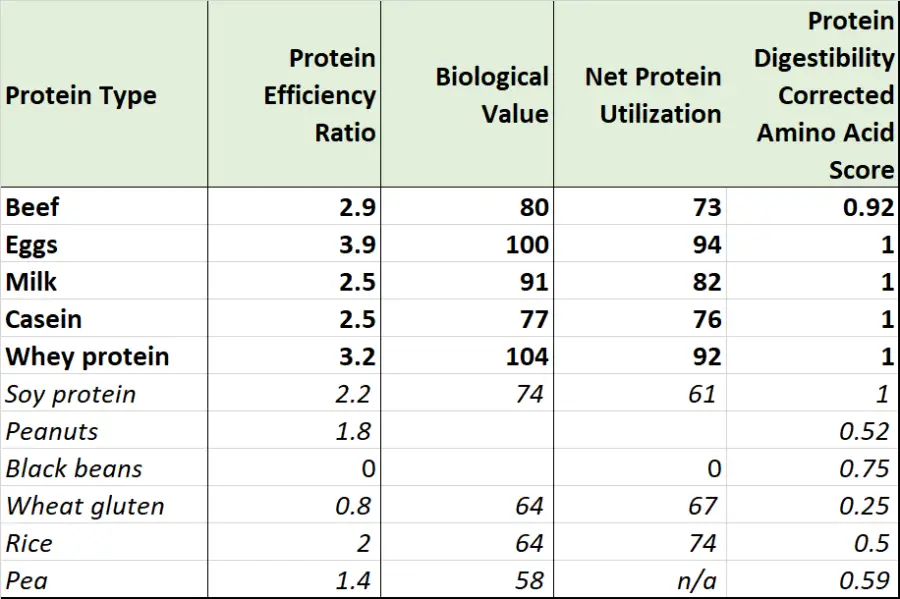
Abundance in essential vitamins and minerals
The 13 essential vitamins are vitamins A, C, D, E, and K, and B vitamins (B1, B2, B3, B5, B6, B12, biotin, and folic acid). The essential minerals are calcium, phosphorus, potassium, sodium, chloride, magnesium, iron, zinc, iodine, sulfur, cobalt, copper, manganese, and selenium.[31]
These nutrients are considered essential because they are vital for the normal functioning of the human body but can’t be produced in your body and must be obtained from food.[32]
Animal-based foods can provide all of the above essential vitamins and minerals in the right ratio and in readily bio-available forms. There is no nutrient your body needs that you can’t find amongst animal source foods, even down to vitamin C. Some essential nutrients like vitamin B12 and omega-3 fatty acids (EPH and DHA) are only available in animal-source food and not found in plant foods. A deficiency in these nutrients can have adverse effects on cognition and synaptic plasticity.[33, 34]
As an example, the table below shows animal-based foods provide an abundance of good quality proteins, essential vitamins and minerals and good fats.
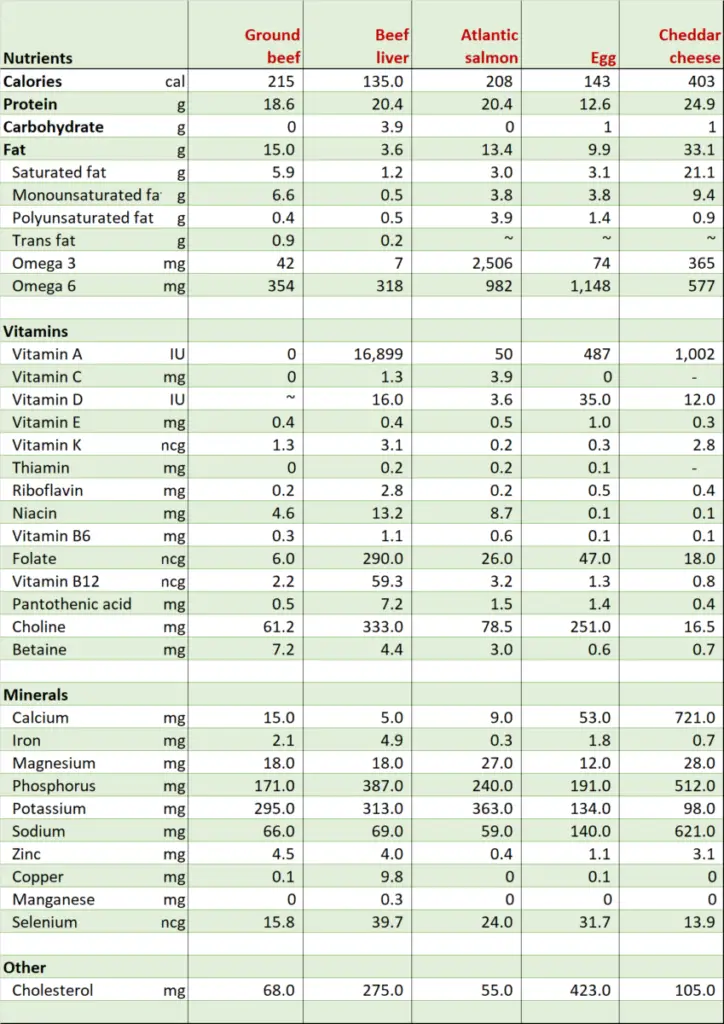
Good source of energy
In a meat-based diet, animal fats will be the main source of fuel for your body.
Contrary to what you may have been told, animal fats are a much better source of fuel for your body because you can avoid the risk of metabolic syndrome. Metabolic syndrome is a condition characterized by disturbed glucose and insulin metabolism, central obesity, mild dyslipidemia, and hypertension, which is found to be positively associated with carbohydrate intake.[35, 36]
When you consume foods containing carbohydrates, your body turns carbohydrates into glucose which then enters the bloodstream. When blood sugar levels rise, insulin is released to transport glucose into your cells to be used for energy or stored as fat if there is excess energy coming in. If you consistently consume carbohydrates (e.g. cereals, bread, pasta, sugary drinks, and other highly processed foods) that causes blood sugar spikes over time, your cells will stop responding to insulin properly, i.e. they have become insulin resistant. This can cause a whole host of issues like inflammation, hormone disruption, and other chronic conditions. [37, 38]
In contrast, when you are eating animal-based foods only which are high in quality protein and saturated fat with a high satiety level, there is a very little amount of carbs and less craving. Accordingly, there won’t be regular blood glucose spikes and you will eliminate the root cause of insulin resistance.[39]
Furthermore, there is no credible evidence of a significant association between saturated fat intake and cardiovascular risk. Instead, saturated fat has been found to have protective benefits.[40, 41]
In addition, replacing saturated fats with carbohydrates or omega 6 polyunsaturated fats has made things worse. An increase in carbohydrate consumption is found paralleling the increased incidence of diabetes and obesity in the USA, while replacing saturated fats with polyunsaturated fats may increase the risk of coronary heart disease, cardiovascular events, death due to coronary heart disease, and overall mortality.[42]
The ancestral carnivore diet allows metabolic flexibility
The totality of evidence points to the fact that our ancestors were hyper-carnivores who dined mostly on large mammals.
We don’t know much about the role that plant food played in our ancestors’ diet, but given what we learn from modern humans’ biology as mentioned above, if there was any plant food at all, the amount would have been negligible. They likely would have only eaten some plant food between successful hunts to survive.
I have written in a previous post that a pure carnivore diet with a total absence of plant foods is perfectly healthy if you know how to do it properly.
However, the inclusion of a little plant food in the ancestral version of the carnivore diet will make it easier and allows you to maintain metabolic flexibility.
If you stick to a meat-only diet, after a long time, your body will get used to animal-based food only. If, for whatever reason, you are forced to eat plant-based food to survive, you wouldn’t feel very well. It will take some time for you to get used to eating plant food again.
Mikhaila Peterson, the daughter of the well-known professor of psychology, Jordan Peterson, cured her depression, rheumatoid arthritis, bipolar, Lyme disease, psoriasis, and dyshidrotic eczema with a beef, water and salt diet. However, she said that having an organic olive and some pepper on her steak at a restaurant triggered a reaction that lasted several weeks with symptoms including joint pain, acne, and anxiety. [43]
Jordan Peterson, urged by his daughter, tried out the carnivore diet and also experienced remarkable improvements in his health conditions after just a few months. His lifelong depression, anxiety, gastric reflux, inability to wake up in the mornings, psoriasis, gingivitis, floaters in his right eye, numbness on the sides of his legs, problems with mood regulation were all gone. But Jordan also reported said having some apple cider triggered an inflammatory response that left him incapacitated for a month. [44]
If you have a severe reaction to just a tiny bit of plant food like them, I wouldn’t recommend trying. However, if you don’t have any specific health issues, it’s not necessary to follow a strict version of the carnivore diet.
By having a small intake of plant food every now and then, your body is well capable of handling both animal and plant foods. If there is ever a need to switch to a more plant-based diet for survival or whatever reason, there wouldn’t be any problem.
The ancestral carnivore diet provides beneficial acute stressors with a negligible amount of plant anti-nutrients
Plants can’t run away from predators and so, to defend themselves, they produce chemicals or anti-nutrients that are harmful when consumed.
When you consume plant-based foods, anti-nutrients present in those foods cause inflammation in your body. In response, your body produces its own antioxidant called glutathione to reduce inflammation. Over time, your body will adapt to those hormesis stressors and become stronger.
These anti-nutrients, therefore, can act as acute stressors to make your body more resilient and stronger. This is similar to the effect that some exercises (e.g. resistance training) can have on your body.
However, while occasional acute stressors can be beneficial, prolonged and consistent stressors will become chronic stress and can be bad for your health.
It is also important to eat those plant foods in seasons. Our ancestors did not have access to out-of-season plant food. By eating with seasons, you will avoid getting the same anti-nutrients all the time and allow your body time to detox.
If you can’t tolerate even just a little bit of plants, of course, it is not the end of the world. As I’ve written in this post, there are a number of alternatives to getting those acute stressors to build a stronger body from non-plant sources. They are exercises, cold exposure, heat exposure, and immersing yourself in nature.
5. Why other diets are inferior to the ancestral carnivore diet?
Vegan diet
The vegan diet consists of plant-based food only. All animal source foods are excluded, even dairy, eggs or honey.
The vegan diet is inferior compared to the ancestral carnivore diet because:
- Plant proteins are incomplete proteins
- Plant foods can’t provide all essential nutrients
- Plant foods are high in natural pesticides.
Plant proteins are incomplete proteins
As mentioned above, humans need 20 different types of amino acids but can only make 11 of them, nine of them, called essential amino acids, must come from food sources. Plant proteins are incomplete proteins because they generally lack one or two essential amino acids.
Plant proteins also have poor quality rankings relative to animal proteins with lower efficiency, biological value, utilization, and digestibility.
Plant foods can’t provide all essential nutrients
Plant foods can’t provide all essential nutrients that the human body needs and people on the vegan diet do need to supplement to avoid deficiency in nutrients such as B12, calcium, iron, zinc and omega 3 fatty acids.
Plant food does not contain vitamin B12 but can be found in abundance in animal source food. Plant foods like nutritional yeast, tempeh, seaweed, chlorella only contain B12 analogs and not true B12.
Vitamin B12 is required for the development, myelination, and function of the central nervous system; healthy red blood cell formation; and DNA synthesis. Vitamin B12 deficiency can serious issues such as anemia, glossitis of the tongue, fatigue, palpitations, pale skin, dementia, weight loss, and infertility. [45]
Some plant food contains minerals like calcium, iron and zinc but their bioavailability is low due to the existence of plant anti-nutrients.
While humans can convert alpha-linolenic acid (ALA) found in plant food to omega 3 fatty acids (important for eye, brain, heart, joint, and mental health), the conversion efficacy is very low. This is probably why vegans and vegetarians are found to have lower levels of EPA and DHA omega 3 compared to omnivores. [46, 47]
Plant foods are high in natural pesticides
Because a vegan diet is 100% plant-based, it is high in plant natural pesticides or plant toxins.
In a paper titled “Dietary pesticides (99.99% all natural)”, Dr. Ames and his team estimate that:
We calculate that 99.99% (by weight) of the pesticides in the American diet are chemicals that plants produce to defend themselves…
Americans eat about 1.5 g of natural pesticides per person per day, which is about 10,000 times more than they eat of synthetic pesticide residues…
Even though only a tiny proportion of the plant toxins in our diet have been tested so far, the 27 natural pesticides that are rodent carcinogens are present in the following foods: anise, apple, apricot, banana, basil, broccoli, brussels sprouts, cabbage, cantaloupe, caraway, carrot, cauliflower, celery, cherries, cinnamon, cloves, cocoa, coffee, collard greens, comfrey herb tea, currants, dill, eggplant, endive, fennel, grapefruit juice, grapes, guava, honey, honeydew melon, horseradish, kale, lentils, lettuce, mango, mushrooms, mustard, nutmeg, orange juice, parsley, parsnip, peach, pear, peas, black pepper, pineapple, plum, potato, radish, raspberries, rosemary, sesame seeds, tarragon, tea, tomato, and turnip. Thus, it is probable that almost every fruit and vegetable in the supermarket contains natural plant pesticides that are rodent carcinogens. The levels of these 27 rodent carcinogens in the above plants are commonly thousands of times higher than the levels of synthetic pesticides.[46]
Benefits of plant food are based on epidemiological studies
People who advocate a plant-based diet usually cite evidence that shows an association between plant food consumption and lower risks of diseases.
However, these findings are generally based on observational studies which can only show associations and do not prove causation.
According to The National Center for Complementary and Integrative Health, a US Federal Government’s lead agency for scientific research on non-conventional medicine:
Research has shown that people who eat more vegetables and fruits have lower risks of several diseases; however, it is not clear whether these results are related to the amount of antioxidants in vegetables and fruits, to other components of these foods, to other factors in people’s diets, or to other lifestyle choices.
Rigorous scientific studies involving more than 100,000 people combined have tested whether antioxidant supplements can help prevent chronic diseases, such as cardiovascular diseases, cancer, and cataracts. In most instances, antioxidants did not reduce the risks of developing these diseases.[49]
Vegetarian diet
The vegetarian diet consists of mainly plant food but may include animal source food such as eggs and dairy.
The vegetarian diet is slightly better than the vegan diet from a nutritional perspective, it is still inferior compared to the ancestral carnivore diet for the same reasons:
- Its main source of proteins is plant proteins which are incomplete with poor quality rankings
- It poses risks of nutrient deficiencies
- It is high in plant toxins.
Paleo diet
The paleo diet aims to mimic what our ancestors ate during the paleolithic period. This diet typically includes food eaten pre agriculture such as meat, fish, fruits, nuts, seeds, tubers, and some other vegetables. Processed food, sugar, grains, legumes, and dairy products are excluded.
This approach makes logical sense because, as noted above, genetically humans remain the same as at the end of the paleolithic period.
However, where it goes wrong is that the paleo diet is constructed based on the diet of hunter-gatherer societies.
As Dr Ben-Dor and his team pointed out, the ecosystem in which our ancestors lived 2 million years ago is totally different from the one in which 20th-century hunter-gatherer societies lived. Our ancestors ate mostly meat whereas hunter-gatherer societies included a lot more plant food in their diet, given the extinction of many large mammals.
The main issue with the Paleo diet is the high percentage of plant food and hence a high level of plant toxins.
Pagan diet
The pegan diet is diet combining the two popular diets, paleo and vegan.
The drawbacks of this diet are similar to those of the vegan and vegetarian diets which have been discussed above.
Mediterranean diet
The Mediterranean diet mimics the way that the people in the Mediterranean region traditionally ate which typically include:
- a wide variety of plant foods such as vegetables, fruits, nuts, seeds, whole grains, olive oil, herbs and spices
- a moderate amount of fish and other seafood and dairy
- a very small amount of meat.
This diet features the traditional eating habits of the Greek, Italian, and Spanish people. They eat what the land provides and eat a variety of food but in moderation.
Two great things about this diet are: (i) it is based on whole unprocessed food and, (ii) it incorporates a wide variety of food that nature provides.
However, because it is a primarily plant-based diet, similar to vegan and vegetarian diets, the Mediterranean diet is high in plant toxins relative to the ancestral carnivore diet.
6. Conclusion
Our ancestors were hyper-carnivorous apex predators who ate mostly meat from large animals for 2 million years.
Despite rapid changes in the environment and available food choices, the human body today is still suited to a meat-based diet.
Accordingly, the healthiest diet for humans today is an ancestral version of the carnivore diet which consists of mostly animal-based foods and occasionally a very small quantity of seasonal plant foods.
Eating what our ancestors ate for 2 million years and eating what our body is designed to eat is the most sensible and natural thing to do.
This has been a long post to argue a point that we shouldn’t have to argue about, so let’s end it with an entertaining video.
In this video, the owner of a dog told a TV audience that she had put her dog on a vegetarian diet and said the dog seemed to be a lot happier on this diet. However, when two bowls of food were brought out, one full of vegetables and one full of meat, guess which one the dog went for?
Like humans, dogs would eat plant food to survive. But, fortunately for them, they haven’t been indoctrinated with the rainbow diet, the healthy food pyramid and healthy plate yet, and they instinctively know what is good for them.
Disclaimer: The information in this post is for reference purposes only and not intended to constitute or replace professional medical advice. Please consult a qualified medical professional before making any changes to your diet or lifestyle.

